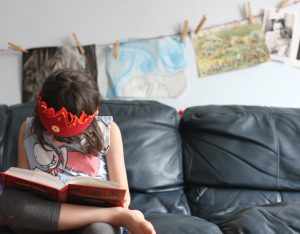“If you want your children to be intelligent, read them fairy tales. If you want them to be more intelligent, read them more fairy tales.”
― Albert Einstein
Fairy tales and other traditional stories are an essential part of childhood development, which is why they have lived on for centuries as a rich oral tradition and have remained in the Oak Meadow curriculum. Oral storytelling is a flexible art that allows stories to be adapted to the Fairy tales and other traditional stories are an essential part of childhood development audience. Many stories that we know from our childhoods were adapted from stories our parents heard as children. In the same tradition, we encourage Oak Meadow parents to tell the stories in their own words rather than reading them verbatim. This lets each parent make changes that reflect their own values and life situation. This is the true spirit of oral storytelling.
 Telling the stories aloud with no pictures accompanying the story helps children develop listening skills as well as the ability to create the images in their minds. Repeatedly retelling the story allows opportunities for children to join in telling the story, which enhances the personal images and allows them to focus on story elements that have personal relevance. The home teacher can also incorporate into the stories nature, family members, friends, and neighbors as a way of making them more personal and meaningful. The underlying themes of a good story are never gender- or race-based, but embody archetypes that are part of the human experience. Changing superficial elements of a story to make it more relatable will not affect the archetypes of the Nurturer, Leader, Jokester, Hero, Mentor, Innocent, or Villain. Retelling stories, drawing pictures, acting out the stories, putting on puppet presentations, or creating dioramas offer opportunities for children to absorb and reflect the underlying themes.
Telling the stories aloud with no pictures accompanying the story helps children develop listening skills as well as the ability to create the images in their minds. Repeatedly retelling the story allows opportunities for children to join in telling the story, which enhances the personal images and allows them to focus on story elements that have personal relevance. The home teacher can also incorporate into the stories nature, family members, friends, and neighbors as a way of making them more personal and meaningful. The underlying themes of a good story are never gender- or race-based, but embody archetypes that are part of the human experience. Changing superficial elements of a story to make it more relatable will not affect the archetypes of the Nurturer, Leader, Jokester, Hero, Mentor, Innocent, or Villain. Retelling stories, drawing pictures, acting out the stories, putting on puppet presentations, or creating dioramas offer opportunities for children to absorb and reflect the underlying themes.
Another tip for telling an archetypal story is to verbally share without too much of an emotional tone ~ especially the emotions in the home teacher’s voice that might instill fear, anger, resentment, etc. As an adult with a rich history and varied experiences, you will respond to the archetypes in a story very differently than a child will. Telling the story without adding layers of your own emotional expression of the story events will allow your child to filter it through a childlike lens.
It’s also invaluable to allow children to absorb the story without interruption, both during the storytelling and afterwards. Talking with a child about every little detail of a story is an established habit for many adults. In fact, it’s practically a cultural norm now for children to be asked to talk about their feelings, impressions, and opinions. This may originate from the belief that we need to encourage children to be more aware and continually teach and quiz them to “make them smart.” It might stem from the efforts to treat the child as an equal voice in the family to build self-esteem and confidence. When a parent is conditioned to “discuss” a fairy tale’s disturbing images with children, this focus on specific elements unnaturally emphasizes details over underlying themes. Discussing the tales afterwards only brings an adult perspective and awareness to story elements and prevents children from developing and using their own filters, based on their developmental stage. Letting the story rest in the child’s mind and heart, and then asking for the child’s interpretation of the story the next day will be of greater benefit.
This post was co-written by Oak Meadow teacher, Leslie Daniels, and Oak Meadow Director of Curriculum Development, DeeDee Hughes.